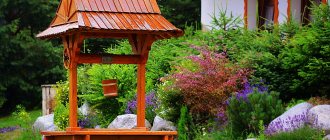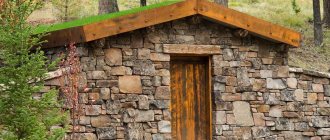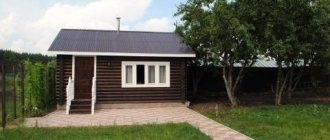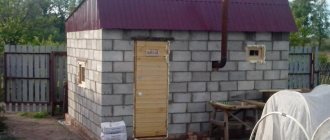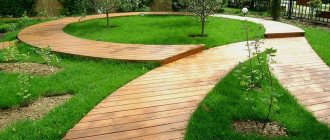Selecting a location
Before you begin to implement your plan, walk around your dacha and carefully examine its corners. Then, when planning how to make a rose garden, this will make it possible to correlate the projects you see with the possibility of implementing them at home.
You will see the usefulness of this idea when you become acquainted with the main types of rosaries. Each of them will find its place in a specific place on the site. It is important that the place for the rose garden is dry and sunny; the best soil is light loam with an acidity close to neutral - 5-7.
Difficulties and errors
The main mistake when arranging a rose garden is creating it in areas that are poorly protected from wind gusts. Because of this, decorative compositions are often destroyed.
The second mistake often made when arranging rose gardens is the lack of drainage. This can be avoided by creating a flower arrangement on a slope.
We recommend that you learn other mistakes when planting climbing roses in the video below:
How to create a rose garden at your dacha by planting bushes of your favorite varieties correctly and beautifully?
To avoid mistakes, you should follow several rules:
- place a rose garden in a flower bed at the entrance to your summer cottage. Due to this placement, you can protect flowers from wind gusts and decorate the house;
- arrange the rose garden away from trees and buildings that can shade it. Lack of sun has a negative effect on rose bushes;
- Before planting roses, fertilizers should be added to the soil. For this purpose, loam is usually used (the price of this fertilizer is about 150 rubles, it can be purchased at a store that sells flowers).
If these recommendations are followed, the rose garden will exist for about five years.
After watching this video consultation, you will learn how to properly arrange a pink rose garden and create the conditions necessary for plants to bloom abundantly:
Types of rosaries by layout
By reading the descriptions of the types of rose gardens, you will be able to determine the most suitable one for your dacha, add it to the scheme and subsequently implement it.
Landscape rose garden-flower garden
For small dachas with a small territory, a landscape flower garden is well suited. He uses varieties of roses with different color shades. Roses are combined with other types of flower plants: annual and perennial.
A landscape rose garden does not require special layouts; it looks good with a pond.
Flowers and colors
When using roses in landscape design, they can be combined with other plants or inanimate objects (as in the examples above). To do this correctly and safely for the plant, pay attention to the following factors:
- plant compatibility (required amount of moisture, light, etc.);
- do artificial inclusions interfere with the normal growth of the flower;
- from an aesthetic point of view - color combinations.
These three factors are the main ones when arranging your garden and yard with roses. Be sure to monitor their implementation.
When selecting plants, consider compatibility
The color of the plants should be combined with other colors
Roses do not require special care
See also Garden design 4 acres. How to arrange a small area with your own hands?
Regular type of rosary
This type of rose garden is the opposite of a landscape one. It is more suitable for large areas. The flower beds in it have regular geometric shapes, plants are planted in rows with equal row spacing, which are sown with grass or paved with tiles.
Depending on the area, a regular rose garden may consist of several flower beds. To avoid bad taste, roses of two or three color shades are planted in each flowerbed.
Roses in landscape design
Roses can decorate any area. They are used to design various types of landscapes. It can be a natural landscape, a formal garden, or a romantic shabby chic.
The determining factors include style preferences, planting scheme and color scheme. The latter is characterized by diversity. The list of the most popular ones includes salmon, red, pink and white shades. Many people prefer plants belonging to rare, unique varieties.
Rose garden-rock garden
The rose garden-rock garden imitates a stone hill covered with roses. To create it, creeping fast-growing varieties of roses are used. Plants quickly cover the surface, creating a blooming and fragrant carpet of flowers.
When combined with stone they create a great design. The plants of these roses are unpretentious in care and do not require special attention.
Soil preparation
Preparing the soil for planting roses should begin about two months in advance. First you need to dig up the soil, preferably with earth transfer. To do this, dig a ditch two bayonets deep. The earth, each of them is thrown to different sides of the ditch. Then the top layer is poured to the very bottom, and the bottom layer is poured to the top.
At the same time as digging, fertilizers are also applied. Digging with transshipment is quite labor-intensive, so in most cases gardeners do shallow digging and plant the bushes in holes. This method is easier, but less effective.
For areas with close groundwater (1.5 m) or marshy areas, drainage must be done. Acidic soils with pH = 5 or less are subject to liming. It may also be necessary to improve the soil composition. For example, sandy soil should be fertilized with clay, or heavy clay soil, on the contrary, should be fertilized with sand.
Note!
- How to make a hot smoked smokehouse - 75 photos of the best ideas and step-by-step instructions
Molds for paving slabs - easy instructions on how to make them yourself (80 photo ideas)
Feeder for chickens - ideas, description of construction and features of creating feeders from scrap materials
Selecting suitable varieties
Rose is one of the most popular garden flowers. Today, a gardener has many varieties to choose from.
The petals of the inflorescences can be simple or double. Plants need regular watering, weeding, fertilizing, spraying, pruning and insulation during the cold season.
The list of eligible ones includes:
Hybrid tea varieties
They have erect stems, medium and large single flowers. They are used for cutting and making bouquets. Caring for them is difficult.
Popular varieties include Mauritius, King Arthur, Rose Gaujard, Copacabana, La Palma, Casanova, Broceliande, Imperatrice Farah, Corfu.
Floribunda roses
They are not used to make bouquets, but are often used for group plantings. Each plant has clusters of inflorescences. Characteristic features include the duration of the flowering period.
The following varieties fall into this category: Kronprinsesse Mary, La Sevillana, Cream Abundance.
Shrub varieties
These roses are divided into three categories. Among them are old, wild and re-blooming. The most popular varieties include Nadia Renaissance and Concerto. Shrub roses are planted in rectangular and round flower beds.
This way they emphasize the rigor, elegance and elegance of the rose garden. By using gardening tools of indeterminate shape, the garden plot becomes creative.
The main advantage of shrub varieties is their large, bright flowers.
Patio
These roses were obtained through the selection of floribunda varieties. The height of the bushes is about 0.5 m.
A distinctive feature of patio roses is their long and abundant flowering. These flowers can be seen on the terraces. Mauritius and La Palma roses are placed in the rose garden.
Miniature varieties
Low bushes are decorated with small leaves and flowers. Roses of various shades appear on compact plants.
Many people grow miniature roses as indoor plants.
Climbing varieties
They need support and regular reduction in length. Roses bloom only once per season. They are also distinguished by a large mass of greenery.
This category includes roses Boogie-Woogie, Penny Lane, New Dawn, Laguna. They are used to decorate gazebos and arches.
They have tough stems and are highly resistant to parasites and fungal diseases. Some varieties bloom several times in one season. Unpretentiousness is an added bonus.
Standard varieties
Standard flowers can be distinguished into a separate group. This is the name given to plants obtained through scion and rootstock. The first is the rose cutting, and the second is the rose hip.
The standard used for grafting climbing roses is usually characterized by an impressive height. This figure cannot be more than 1.5 m. This method of cultivation is complex. Standard roses are recommended to be planted next to low plants.
Creeping, spreading and shrub roses are classified as ground cover. Leafy bushes have a dense crown and a tall stem (above 0.5 m). By combining them, you can decorate those areas of the garden that are not particularly attractive.
How to choose healthy seedlings
Healthy seedlings should not have a whitish coating or black spots on the stems and leaves; their bark should be green and not wrinkled. The seedlings should have two or three stems about twenty-five thirty centimeters high.
Buy rose plants with an open root system immediately before planting to prevent the roots from drying out. It is better if the roots are with clods of earth, so they are protected from drying out longer and take root better.
It’s even better to buy seedlings with a protected root system, in containers. In this case, you don’t have to rush to plant, as long as the container is large enough for the roots to grow. Roses in containers are usually sold in bloom, which eliminates the possibility of error when choosing the color of the flower and even its aroma.
Ideas
Since we have decided to use roses in garden design, let's look at interesting ideas on how to use them correctly. There are no specific strict options for arranging a site with roses - who said that you need to act one way or another? But within the framework of one project, established rules must be followed in order to achieve the desired result. Therefore, we offer possible ideas and schemes on how to turn them into reality.
| Site area | idea | Variety of roses |
| Front yard | Decorating a gazebo with roses, a row of bushes near the walls of the house | Curly, tea rose |
| Backyard | Arch, composition with a waterfall or pond | Curly, any type for composition |
| By the yard (outer part) | Hedge, flower garden | Low-growing frost-resistant |
Let's study in more detail the proposed options and ways to implement them.
You can arrange the site in any way
You can decorate anything with roses
Arches with roses in the garden will look very beautiful
See also: Gazebo design in landscape design of different styles
Vertical rose garden
This option is very convenient for arranging a shady gazebo. Using climbing roses, you will achieve the desired effect and turn an ordinary gazebo into a fabulous corner. To do this, you need to plant the bushes at a distance of half a meter from the walls of the gazebo in a fairly dense row. Then you need to make fastenings. Drive short stakes into the ground next to the bush (so as not to damage the root), tie a thick rope to it (white twine is best), and secure it to the walls and roof of the gazebo in accordance with the pattern you want to achieve.
As soon as the rose begins to sprout, you need to guide it along the rope, thereby securing it to it. Then she will independently adhere to this support.
Another beautiful and unusual version of a vertical rose garden is an arch. Such an element in the landscape design of your site will give it some zest. It is built on the same principle as the frame of the gazebo, only instead of ropes, a metal arch becomes the support. If desired, you can attach several ropes to this base to give more volume to the composition.
As soon as the rose begins to grow, it needs to be directed in the right direction
Climbing roses will perfectly complement the landscape design of the yard
See alsoCreate a harmonious garden design
Hedge
We are used to seeing hedges built from a certain type of bush. But you can also create it from roses. This idea will look even better, and especially when it blooms.
You can build such a miracle both in the front yard and in the backyard, and frame the path from the gate to the house. The composition will look advantageous in any area of the site and fulfill its function.
There is nothing complicated in its manufacture. The case is divided into several stages. The first is the most important stage: you need to draw a plan for the location of the fence. You can realize any ideas: from a simple line to the most bizarre shapes. In order not to get confused, and subsequently plant the bushes correctly, having achieved the desired pattern, do not ignore this stage.
Arches with roses will look very beautiful
Arches of roses will create a stunning atmosphere in the yard
You need to choose the color of roses carefully
We transfer the drawing to the surface of the earth. Having calculated the required space, the distance between the bushes and the shape of the fence, make notes on the areas of land intended for planting.
Let's move on to choosing roses. For hedges it is better to use low-growing bushes. They are usually compact and ball-like, so they can create a hedge effect, especially if planted close together. But make sure that the distance is sufficient for the normal functioning of the plant and the roots do not interfere with each other.
All that remains is to finish what we started and plant the bushes in the holes made in the previously designated places.
You can use tall or medium bushes. But they will leave gaps below, and by framing the path, they will interfere with free passage. The most advantageous option is the low-growing variety.
Roses can be combined with other flowers
You can combine roses with any number of flowers
See also Do-it-yourself front garden: where to start designing and what to pay attention to?
Compositions
Let's get to the most interesting part. Here you can combine all landscape design techniques and turn your fantasies into reality.
When composing a composition, it is necessary to take into account all the nuances. Let's figure out what awaits us. In the overall score, pay attention to:
- location (shade, light, humidity);
- the presence of a strictly developed layout;
- number and type of roses;
- presence of other plants;
- compatibility of roses with other elements of the composition;
- ease of subsequent care.
So what do we mean? When using roses to create a composition with non-living elements, pay attention to whether there is enough space for the roots to develop, as well as ease of watering, and whether any elements will create an unfavorable atmosphere for the plant to grow (for example, a pond). When combining with other plants, be sure to ask whether they will take root together.
As in the previous option, this one requires a precise plan, even more strict. The main element in the proposed compositions will be an inanimate object (fountain, pond), and roses serve as an arrangement, so you need to concentrate attention on it. Make all the necessary measurements, calculate the required amount of space and material, and also create an accurate drawing of the location of objects. To do this, it is better to invite a landscape designer, which will significantly reduce your work and time.
So, many housewives dream of their own “swan lake”. Why not? It is quite possible to create it in your yard. Start with a pond. Make a good water supply and pumping system. We focus on the latter, since poor water circulation will lead to its blooming and the formation of an unpleasant odor.
When composing a composition, it is necessary to take into account all the nuances
When combining with other plants, be sure to ask whether they will take root together
It's easy to create stunning landscaping with roses
A “savage” stone is better suited for framing a pond. It will give a relaxed appearance. However, you can use any decorative stone.
Having completed the main part, we move on to the subsequent design. We organize planting of roses. In accordance with the planned plan, we plant the plants in the appropriate order. It is better to plant them at a short distance around the pond, or make flower beds nearby. A bench is well suited for such a composition. You can also decorate it with roses, and make a path leading to it from the pond, filling it with fine gravel and planting low-growing species along it.
The main detail in the next idea is a fountain. The first and second stages are no different. It is also necessary to draw a plan and purchase a good system for proper circulation of water in the fountain. Then complete the composition with roses.
You can also use a waterfall as a base - this combination will also be attractive. If you don't want to deal with water, make a dry pond. To do this, you need a frame made of any stone (as for a pond with water, only a low one). Fill the resulting shape with small pebbles, you can draw something inside, painting certain areas. To do this, use spray paint, or pre-soak groups of pebbles in another type of paint.
So, you can create any composition using everything at hand.
Roses in the yard will give a pleasant mood
Design can be created from available materials
See also: DIY garden paths: drawings and design options
Distance between bushes
After the area has been dug up, it is necessary to dig holes a month later. The holes should not be too large, 40 cm deep and wide. If the soil is very dense, you can deepen the hole another 15 cm by adding fertilized soil when planting.
The distance between the holes depends on the type of roses. For miniature roses it is 30 cm, patio roses - 50 cm, tea roses - from 50 to 100 cm, climbing roses - 2-3 m. For ground cover roses, this distance can be about two meters.
The size of the seedlings does not at all determine the planting density. Excessive thickening leads to shading and lack of light for roses; sparse planting promotes the development of weeds.
Planting bushes in holes
It is not difficult to plant bushes with a protected root system. To do this, just remove the plant from the pot and place it in the hole, sprinkled with a little soil. On plants with an open system, trim (refresh) the roots before planting, this will help them take root faster.
Place a mound of soil at the bottom of the hole up to the level of the roots. Hold the stem vertically over the hole while covering it with soil and stomping it down. Form a mound above the planted bush. Regardless of planting method, water the plants. After watering, cover all plants with soil.
Rose garden care
Indispensable measures for caring for a rose garden are watering, pruning and protecting plants from diseases. Moderation should be observed when watering. Roses do not like waterlogged soil. In addition, waterlogging contributes to the development of diseases. When dried out, buds are dropped and shoot growth decreases.
Watering plants can be combined with mineral fertilizing. Weeds find a place in a young rose garden, so it is necessary to do weeding more often. Rose plants, after grafting from dormant buds, send up wild shoots that must be pruned regularly.
Under climbing varieties of roses it is necessary to install retaining structures. For the winter, do not forget to cover roses from frost with dry leaves, soil and, of course, snow.
If we happen to see beautiful rose gardens, then, undoubtedly, they are grown this way thanks to the careful implementation of the measures that we have written about here.
Where to place the rose garden
Planting roses in landscape design should be on the sunny side or in the parterre lawn area. Since the latter is considered the most spectacular and elite lawn, it should not be hidden from prying eyes. The ground lawn is decorated with flower beds and ornamental shrubs.
The location should be well lit and protected from the wind. The best option for installing a rose garden is considered to be partial shade on the south side. For the normal development of flowers, they need sunlight and shade. If there is an excess of the former, then nothing good will be expected. Roses should be in the shade for at least 3 hours during the day, but at the same time they should receive sunlight for at least 6 hours.
Beauty. This is the first and most powerful argument. Whatever one may say, a rose is a flower of extraordinary beauty.
Flooded soils are a taboo for growing roses. It is recommended to plant the queen of flowers on land where there is well-drained loam. Acceptable soil acidity is 5.5-6.5 pH. On clay soils you will have to create a suitable microclimate. To do this, you need to add a little sand or peat mixture to the ground.
To arrange flowerbed arrangements you will need much more space than for a vertical rose garden. Here it is necessary to provide a small “border” of low-growing evergreen shrubs.
At the moment there are many fans of this culture. And the breeders took care of them, providing a large selection of different species.
Climbing roses grow best close to home. In this case, the plant may cling to the facade of the building. When it is not possible to plant them under the foundation of the house, roses are placed near the gazebos. A flower garden of climbing roses can be arranged anywhere on the site, but this will require portable arches or decorative partitions. Varieties with abundant flowering grow well near a pond. In this case, they act as a hedge.
Roses do not require special feeding or very complex care.
Important! When choosing a location for a rose garden, consider its scale. Plantings are selected according to shape and height. The rose garden is planted in separate or large groups. A polyanthus rose is planted in front, and a remontant, tea and park rose is planted in the background. Photos of landscape design with a rose garden will help you decide on the composition of roses on your site.

